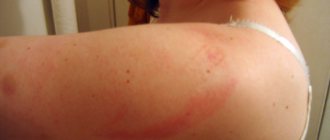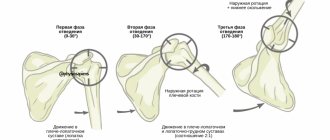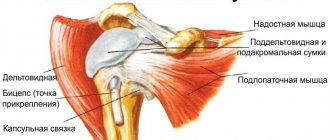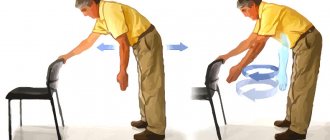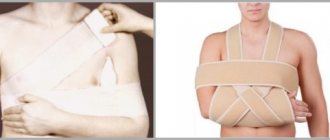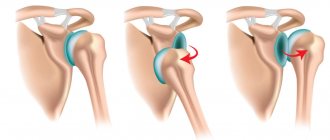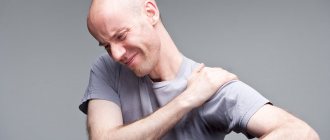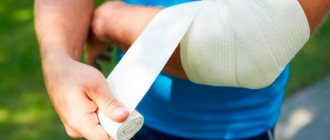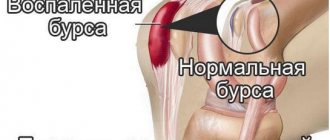Damage to the shoulder joint is a complex of disorders of the physiology of the shoulder joint, in which it loses its functionality and integrity, and the articular capsule or labrum, tendons are also damaged. All these deformations lead to discomfort in the shoulder joint, severe pain both when moving the shoulder and at rest.
As the long-term practice of doctors who treat and diagnose diseases of the musculoskeletal system caused by injuries and its changes due to degenerative anomalies shows, these damages are caused by both injuries and improper trophism of tissues, which increases the likelihood of damage.
Human shoulder joint
- This is a complex anatomical structure that ensures rotation of the limb in three planes, due to the specific structure of the joint and muscle attachment. It is the complexity of this design that is the main reason for its vulnerability, since even the slightest violation of the integrity of the bone, joint capsule, tendons and muscles leads to severe pain, loss of joint mobility and the need for treatment.
About the shoulder girdle
The shoulder girdle consists of structural formations, the shoulder blades and the collarbones, which together and thanks to the articular connections determine the normal position of the humerus and shoulder joints as a whole. Due to the high mobility of the shoulder girdle and heavy loads , this area is susceptible to damage.
Very often, patients come to clinics complaining of a shoulder injury. That is why this disease most often appears among all other joint injuries. Shoulder injuries occur in people of all ages and genders . Both men and women often injure the shoulder girdle, which, of course, requires specialized medical care. And before going to a specialized department to eliminate a shoulder injury, we recommend immobilizing the limb so as not to damage the shoulder girdle even more during movement.
The most important rule for a patient is not to self-medicate an injured shoulder, otherwise the wrong approach can only worsen the condition or even lead to complications!
Shoulder joint injury treatment
Damage to the labrum of the shoulder joint
Any damage to the labrum of the shoulder joint requires immediate treatment, as well as elimination of the consequences of the injury or the factors that caused it. Initially, the patient must limit the movements of the joint so that bones that move incorrectly do not harm the soft tissues. After this, the victim of a dislocation must immediately undergo a magnetic resonance imaging procedure, which will show whether damage has occurred to the rotator cuff of the shoulder joint or whether the injury is purely ligamentous in nature. The doctor who examines the patient must be a qualified specialist, since the correctness of the diagnosis and the timeliness of treatment measures taken, the damage can be eliminated relatively quickly, and the health of the joint will not be affected.
Causes of shoulder injuries
The causes of shoulder injuries usually come down to the fact that damage occurs either to the bones that make up the shoulder joint, or to the muscles, ligaments and tendons. All this can be provoked by various damaging factors, for example:
- Heavy physical exercises, the main force of which falls on the upper limbs, namely on the shoulder joints and their ligaments;
- Severe traumatic injuries: falls on an outstretched arm, dislocations and bruises;
- Degenerative changes in the shoulder that appear with age and are characterized by insufficient blood supply to all components of the shoulder. Poor blood supply leads to impaired nutrition of bones and tissues, and therefore increased trauma;
- Hereditary predisposition to diseases and injuries of the shoulder, which is most often associated with impaired functioning of connective tissue in the body as a whole;
- Poor nutrition, which causes cartilage and bone tissue to become less durable and more susceptible to traumatic damage.
We have identified the main causes of shoulder injuries so that you can familiarize yourself with them and remove yourself from their impact as much as possible.
What to do if you have a bruised soft tissue of the shoulder?
First aid for bruises is cold. Applying ice or a heating pad with cold water to the injured area helps stop the development of swelling and reduce the intensity of pain. Cold causes vasospasm, which reduces hemorrhage.41
If shoulder pain is severe, more serious injuries may be suspected, especially if there is a significant limitation in the mobility of the injured limb. In this case, you need to immobilize the arm and go for examination.41
With bruises, the integrity of the skin is usually not compromised. But if this happens, it is necessary to apply a sterile bandage to the injury site.18, 41
Symptoms of Shoulder Injuries
Symptoms of shoulder injuries mainly boil down to the main thing - pain . The pain usually occurs immediately after the injury, and can intensify if the shoulder is seriously injured. It can be intense and even unbearable, or it can be aching. In addition, with a shoulder injury, the pain usually intensifies when putting pressure on the injured shoulder, when moving the arm in the shoulder joint (which sometimes turns out to be completely impossible).
Typically, the more severe the pain and injury to the shoulder, the more severe it is . It is the pain symptom that occurs after a shoulder injury, and the inability to fully move the injured arm, that forces the patient to go to the clinic for medical help. Remember, don’t put off consulting a good traumatologist until later. After all, the sooner it is possible to determine the cause of a shoulder injury, the sooner you will receive the necessary medical care to eliminate the existing damage, and the sooner your full recovery will occur.
kinds
kinds
There is also an isolated change, affecting only the supraspinatus tendon, and a combined injury, in which other structures of the shoulder are involved to varying degrees in the process.
Treatment of shoulder injuries
Treatment of shoulder injuries can be conservative or surgical , and in each case it must be selected individually. You will receive this exact treatment, individual and effective, by contacting our specialized clinic. It should be noted that our doctors offer only the most modern, unique and effective methods of treating shoulder injuries, which lead to complete elimination of damage and your speedy recovery.
Sometimes, to treat shoulder injuries, high-quality conservative therapy is sufficient, which includes not only taking medications, but also special physical therapy, dosed physical activity, and the necessary methods of immobilizing the limb for a specific period. At the same time, by following all the doctor’s recommendations and following his prescriptions, our patients recover very quickly.
Comprehensive treatment of traumatic shoulder injuries in our clinic, prescribed by our doctors, allows us to achieve long-term remission and postpone surgery.
In addition, is now actively used to treat shoulder injuries , namely arthroscopy, which is a minimally invasive intervention that makes it possible to restore damaged shoulder structures. The essence of arthroscopy is that the operation is carried out under the direct control of a video camera, which is placed in the damaged shoulder joint, and with the use of special instruments that carry out the necessary surgical manipulations (i.e., restoration of damaged structures). This treatment is now most effective and perfectly solves the problem of this pathology.
Our specialists also use other latest technologies, modern and reliable techniques that allow the patient to return to normal life after a shoulder injury . In addition, the specialists of our clinic always try to help the patient as much as possible, and if surgery can be delayed, they do everything possible to do this.
Video reviews about shoulder joint treatment
Yakunina Galina, arthroscopy of the shoulder joint Vladimir Bulaev, 80 years old - arthroscopy of the shoulder joint
Supraspinatus brachii tear
Rupture of the supraspinatus muscle of the shoulder Rupture of the supraspinatus muscle of the shoulder develops as a result of the implementation of a pathogenetic mechanism, the essence of which is excessive impact, the force of which is aimed at lengthening the tendon (stretching). More pronounced changes in the fibers are formed against the background of degenerative or inflammatory changes. In this case, the injury suffered is more severe, affecting several components of the shoulder at once.
Shoulder Mobility Testing
The Apley's Scratch Test can show how both shoulder girdles work in coordination with each other and can also determine the capabilities of each shoulder joint individually.
YouTube0:55
Here the right arm moves, performing functional internal rotation, and the left one, at the same time, performing functional external rotation. The goal is to bring your fingers together enough that they touch behind your back. Then the hands change and you check the other side. During the test, you can slightly change the position of the spine (bend, for example) or gradually raise your lower arm up.
Pay attention to the distance between the palms during simultaneous functional internal and external rotation. Also note whether you experience pain and whether there is a difference between the range of motion on both sides.
What you feel is the most important aspect of this test, while hand coordination takes a back seat.
Signs
A rupture of the supraspinatus muscle is manifested by quite characteristic symptoms, which include:
- Sharp pain that appears immediately after injury. In the case of gradual damage to the fibers against the background of a pathological process, pain may increase gradually.
- Increased sensations of discomfort during movements in the shoulder, especially when trying to raise the arm up.
- Impaired stabilization of the joint, in which habitual dislocation may develop with frequent release of the head of the humerus from the glenoid cavity under normal loads.
- The appearance of inflammatory signs - damage is accompanied by inflammation of the tissues and ligaments (tendonitis) with redness of the skin, swelling and an increase in the volume of the shoulder.
The severity of clinical signs of tendon fiber rupture depends on the severity of the pathology.
Unilateral testing of functional internal and external rotation
If you find asymmetrical movement, pain, or noticeable mobility deficits (fingers not close to touching) during the Epley Scratch Test, it's time to try other tests to help find the source of the problem.
When you move with only one arm, the thoracic spine and rib cage do not provide additional mobility. During the Epley Scratch Test, both arms move toward each other and the thoracic spine is easily tested to see how well it can provide additional range of motion when movement in the shoulder girdle is no longer possible. Doing the movements with just one arm allows you to focus only on the shoulder.
Test each shoulder individually during functional internal and external rotation. During external rotation, you should reach with your fingers to the prominent ridge of the opposite scapula.
As for checking functional internal rotation: touching the inferior angle of the scapula on the opposite side with your fingers indicates normal mobility. The testing positions are the same as for assessing simultaneous functional internal and external rotations.
Ultrasound
Ultrasound
In order to reliably determine the location, nature and severity of the injury, the orthopedic traumatologist prescribes an additional examination. It includes techniques that allow you to visualize internal structures. These include radiography, tomography with layer-by-layer scanning of tissue (tissue visualization can be carried out using X-rays or the effect of resonance of atomic nuclei in a magnetic field), ultrasound of components of the musculoskeletal system, as well as arthroscopy (a minimally invasive diagnostic and treatment technique). The choice of examination method is determined by the results of the examination by the doctor, as well as the technical capabilities of the medical institution.
Possible consequences if left untreated
Untimely qualified medical care or the absence of it at all, firstly, leads to an increase in the duration of treatment and rehabilitation. When a shoulder is bruised, complications may develop, a deterioration in the clinical picture, including the appearance of additional unpleasant symptoms (hematoma, tissue swelling, redness (hyperemia), itching, cutting and aching pain, difficult to treat with analgesics, antispasmodics). Also, due to a bruised shoulder, hemarthrosis (accumulation of blood in the joint) and bursitis (inflammation of the synovial bursa) are often diagnosed.
| Elbow bruise | To the list of articles | Forearm bruise |
Scapulohumeral rhythm testing
Now that we have some understanding of the movements performed by the shoulders during functional internal rotation with one and two arms, it is time to evaluate rhythm and coordination.
In order for the shoulder to travel its full path without compensatory movements, the scapula and humerus must move synergistically and rhythmically. In sports medicine this is called the scapulohumeral rhythm.
Proper scapulohumeral rhythm means that for every 2 degrees of elevation movement of the humerus, the scapula should rotate upward 1 degree until the limit of motion is reached. However, the numbers won't tell you anything. The point at which the blade stops rotating is more important.
At approximately 120 degrees of arm elevation, the shoulder blade begins to rotate upward. If your shoulder blades become clearly visible on the sides of your body before reaching 120 degrees when you slowly raise your arms, this indicates that the posterior tissues of the shoulder are toned and tense.
In addition, the symmetry of movements on both sides should be assessed. Do your shoulder blades begin to rotate simultaneously or is their rhythm asymmetrical?
If the rhythm is disrupted, your best bet is to start working on soft tissue mobility in the back of the shoulder girdle.
This can be simple movements focusing primarily on the latissimus dorsi and other surrounding muscles using a foam roller or through self-myofascial release techniques. You can also use movements aimed at developing mobility, for example, adding stretching to your training program.
The choice is yours, and the only wrong decision is to do nothing at all.
